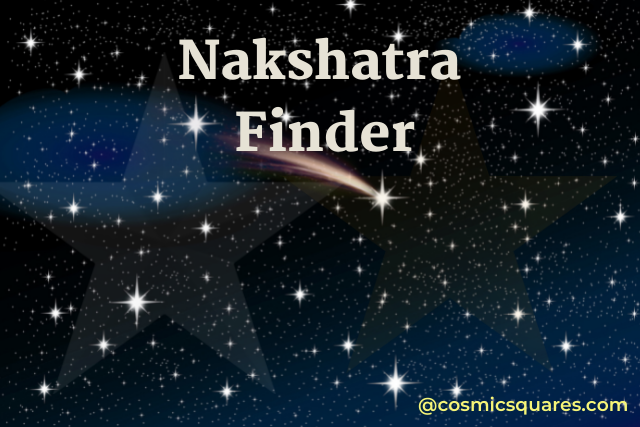No products in the cart.
Nakshatra Finder
In Vedic astrology, Birth star or Janma Nakshatra or Nakshatra is the name of the constellation in which the Moon was located at the time of the birth. It is often referred to as Lunar Mansion. The word Nakshatra means "something eternal", or in Sanskrit "Naks"- translates to the sky and "shetra" referring to an area or a particular region, so together it means a specific area of the sky.
Other than Vedic Astrology, this phenomenon of classifying constellations based on the Moon is also seen in Persia, Arabia, Egypt, Babylonia, China under various terms like Manzil, Sieu, etc.

The Moon travels approximately 27.3 days to complete its orbit around the Earth relative to the "fixed" stars (the Moon's sidereal period), about 13° 20' per day, hence the 27 Nakshatras. The Ecliptic sky has 27 equal reference points, and each one is a nakshatra or constellation. The Moon is believed to travel across one reference point or constellation in a single day. So, the Moon's revolution divided by 27 divisions of the Nakshatra gives you the arc of each Nakshatra, measured as 360/27 = 13.33′ (2). An arc is measured in degrees (°) and minutes (′).
The reliable way to find your Nakshatra is by using your birth date, time and place.
What’s My Birth Star or Nakshatra?
Nakshatra or the Birth Star is an important element of Indian Vedic Astrology. There are 27 nakshatras considered for calculations. Enter birth date in the nakshatra calculator below to find your nakshatra or birth star.
What is Pada and Rashi in Nakshatra?
Each constellation/nakshatra consists of 13 degrees 20 minutes of arc, and each one has been further divided into four quarters named Pada. There is a total of 108 padas (27×4) which is 03 degrees 20 minutes (360/108) each. In other words, a pada is 1/4th of the nakshatra.
There are 12 moon signs or rashis, and each sign occupies 30° (360/12). Each Rashi has 2 ¼ nakshatras and 9 padas. Each pada represents a Rashi of the zodiac in a group of three nakshatras.
Types of Nakshatra:
Nakshatras are classified based on their qualities, i.e. Chara, Sthira, Mrdu, Ugra, Tikshna, Kshipra and Mishra. Based on these qualities, they are chosen for various actions of life.
Chara Nakshatra: Movable: Shravana, Dhanishta, Shatabhisha, Punarvasu, and Swati are movable. They are auspicious for activities needing movements such as acquiring vehicles, gardening, going on procession etc.
Sthira Nakshatras: Fixed, standard, stable: Rohini, Uttara Phalguni, Uttara Ashadha and Uttara Bhadrapada are fixed. They are favourable for activities that require persistence, such as coronations, laying the foundations of cities, sowing operations, planting trees etc.
Mrdu Nakshatras: Delicate: Chitra, Anuradha, Mrigashirsha and Revati are soft. They are favourable for subtle things such as wearing new apparel, learning dancing, music and fine arts, sexual union, the performance of auspicious ceremonies etc.
Ugra Nakshatras: Aggressive: Bharani, Magha, Poorva Phalguni, Purva Ashadha, and Purva Bhadrapada. These constellations are favourable for activities that require violence, force, weapons, confronting enemies etc. Activities such as demolishing a structure, setting fires, capturing others with force, battles etc., are favoured in this Nakshatra.
Tikshna Nakshatra: Sharp: Moola, Jyeshtha, Ardra and Ashlesha are sharp. They are favourable for destructive activities such as incantations, invoking spirits, imprisonment, murders (Marana mantra), separation of friends (ucchatana mantra) etc.
Kshipra Nakshatra: Agile: Ashwini, Pushya, Hasta and Abhijit are Swift constellations. They are favourable for activities involving swiftness such as putting ornaments, pleasures and sports, administering medicine, starting industries, undertaking travels etc.
Mishra Nakshatra: Mixed: Krittika and Vishakha are mixed constellations. They are favourable for activities like worshipping, fire ceremonies, purchasing furniture and electronics.
What is the Significance?
Every constellation is a unique personality. Birth star governs the realities, feeling and experiences of an individual.
It has instincts, likes, dislikes and is adept at doing certain things better than others. By knowing the Nakshatra of an individual, we can understand their strengths and challenges.
Naming: Depending on the Nakshatra that a baby is born in, you can choose favourable, lucky syllables that the name can start with.
Nakshatras are favourable as they offer stability. Activities such as commercial transactions, taking medicine, travels, coronation, planting of trees etc., pretty much every action can be planned for specific success.
In Vedic astrology, several astrology rituals and poojas are based on your Nakshatra or Birth star.
Every Nakshatra has a symbol, a deity and a ruling planet. Mind, consciousness is trapped following these three players for a native.
Nakshatra Attributes:
1. Yoni
There are 14 Yonis (animal symbols) in Vedic astrology assigned to nakshatras :
Nakshatras | Yoni |
|---|---|
Ashwini, Shatabhisha | Horse |
Swati, Hasta | Buffalo |
Dhanishta, Purva Bhadrapada | Lion |
Bharani, Revati | Elephant |
Krittika, Pushya | Sheep |
Purva Ashadha, Shravana | Monkey |
Uttara Ashadha | Mongoose |
Rohini, Mrigashirsha | Serpent |
Anuradha, Jyeshtha | Deer |
Ardra, Moola | Dog |
Punarvasu, Ashlesha | Cat |
Magha, Poorva Phalguni | Rat |
Chitra, Vishakha | Tiger |
Uttara Phalguni, Uttara Bhadrapada | Cow |
2. Ganas
There are three ganas (Deva, Manuj, Raksha)
Deva ganas: Divine
Ashwini, Mrigashirsha, Punarvasu, Pushya, Hasta, Swati, Anuradha, Shravana, Revati
Manuj Ganas: Human
Bharani, Rohini, Ardra, Poorva Phalguni, Uttara Phalguni, Purva Ashadha, Uttara Ashadha, Purva Bhadrapada, Uttara Bhadrapada
Raksha Ganas: Demon
Krittika, Ashlesha, Magha, Chitra, Vishakha, Jyeshtha, Moola, Dhanishta, Shatabhisha
3. Nadis
There are 3 Nadis (Physical constitution)
Adi: Vata
Ashwini, Ardra, Punarvasu, Uttara Phalguni, Hasta, Jyeshtha, Moola, Shatabhisha, Purva Bhadrapada
Madhya: Pitta
Bharani, Mrigashirsha, Pushya, Poorva Phalguni, Chitra, Anuradha, Purva Ashadha, Dhanishta, Uttara Bhadrapada
Antya: Kapha
Krittika, Rohini, Ashlesha, Magha, Swati, Vishakha, Uttara Ashadha, Shravana, Revati
